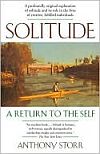 Storr, Anthony. Solitude: A Return to the Self.
Storr, Anthony. Solitude: A Return to the Self.
New York, Free Press, 1988; HarperCollins, 1989.
This is an essential book for the psychology of solitude. Not only is Storr impeccably credentialed for his subject as a practicing psychiatrist and Oxford scholar, but his book is engagingly written, informative, and packed with examples of writers, composers, and philosophers who illustrate Storr's points about the connection between solitude and creativity.
The examples reflect the author's intimacy with the literature of the past and present, not reducing his science to abstractions or anomalous case studies. With his step-by-step demonstration of the efficacy -- indeed, necessity -- of solitude, and his carefully drawn biographical material and command of the psychology classics, Storr is an excellent guide.
For all that, it must be said that Storr is not offering an historical angle to solitude. He is not looking for famous solitaries, be they hermits or monks East or West. He is not developing a psychology of eremitism.
Storr builds an analysis of the psychology of self, breaking down the components of infancy and childhood, the characteristics of the temperaments and personalities, and the tendencies of solitude in the creative person. His first concern is to consider solitude as the "capacity to be alone," and his final chapter concludes that the most profound human experiences have very little to do with interpersonal relationships. Writes Storr:
"Some of the most profound and healing psychological experiences which individuals encounter take place internally, and are only distantly related, if at all, to interaction with other human beings."
Here are a few notes on each chapter:
- The Significance of Human Relationships.
Challenges the notion that human relationships are the "touchstone of health and happiness." Freud's instinct theory and insistence on the fundamental childhood experience, writes Storr, "does less than justice to the importance of work, to the emotional significance of what goes on in the mind of the individual when he is alone, and more especially, to the central place occupied by the imagination in those who are capable of creative achievement." -
The Capacity to Be Alone.
The capacity to be alone is "linked with self-discovery and self-realization; with becoming aware of one's deepest needs, feelings, and impulses." -
The Uses of Solitude.
Identifies what Romain Rolland called the "oceanic" feeling; contrasts the Freud and Jung interpretations of the ecstatic as regression (Freud) versus high achievement (Jung). Solitude is related to this feeling. - Enforced Solitude.
The psychological effects of solitary confinement, sensory deprivation, prolonged illness, physical handicaps such as deafness. - The Hunger of Imagination.
Imagination of "divine discontent" and the role of adaptability and fantasy. - The Significance of the Individual.
Interests and fields of endeavor often define individuals more clearly than their interpersonal relationships. Creative endeavors have traditionally been defined in terms of serving the community, but the highly creative and deeply religious have not related their work or attainments in this way. Modern psychology idealizes human relationships to the point of misleading people. - Solitude and Temperament.
Extraversion and introversion applied to solitude. A rich chapter correlating Jung, Warringer, Hudson, and Gardner. - Separation, Isolation, and the Growth of Imagination.
Primarily historical examples of writers. -
Bereavement, Depression and Repair.
Childhood loss and its effects on temperament in adulthood, with English poets as examples. - The Search for Coherence.
Examples of "creative individuals whose principal concern was not primarily with human relationships but with the search for coherence and sense." Extends the temperaments to the individual's relationship with the external world, using famous philosophers as example. - The Third Period.
Old age and the waning of emotion dependence and shift of preoccupation to internal concerns. Composers and novelists as examples. - The Desire and Pursuit of the Whole.
The sense of unity or harmony with self, others and the universe is far more complex that Freud's sexual and pleasure principle or regression. The sense of unity can be triggered by nature, art, religion, love, childbirth, knowledge, and creativity, but also by solitude and silence. Concludes Storr: "The human mind seems to be so constructed that the discovery, or perception, of order or unity in the external world is mirrored, transferred, and experienced as if it were a discovery of a new order and balance in the inner world of the psyche." Jung and Maslow are the only psychologists to focus on the experience of unity and its healing effects.
¶